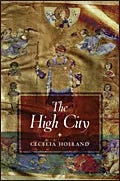Raef first sees the high city "half-visible in the haze.... A dome shone golden in the sunset, or it might have been the setting sun shining on a cloud.... Then his heart leapt, and he realized, That is Constantinople." Before glimpsing the city, he must survive a shipwreck and a battle. The High City is #5 in Holland's "Soul Thief" series, but readers are plunged into its world with such immediacy, there's no need to have read the earlier novels. "Raef put his hands on the oar, its grip wrapped in frayed rope, and a shock went up through his arms. He felt the sea rise under him like a monster coming out of the deep."
Raef finds the surges of psychic awareness that occasionally visit him more annoying than useful. Mourning a comrade's death in distant Kiev, making a roundabout journey he hopes will lead back, eventually, to his more distant homeland, he has thrown his lot in with Greek-speaking shipmates who think him slow-witted because he doesn't understand their language. In Constantinople, he arrives as an accidental and unwilling celebrity among people even more alien. The custom of performing obeisance to the emperor disgusts him as much as the city's magnificence awes him. Without formally joining the imperial contingent of Varangian warriors whose Scandinavian language he understands, he makes friends among them, falls in with their life and finds himself inadvertently in service to Emperor Basil II. He also falls in love with a woman's eyes, in which he sees "a desperate, aimless longing, a shimmering desire."
The High City puts readers in the midst of tenth-century Constantinople. The characters can seem emotionally blunted, because they take for granted a level of brutality and risk that would make most modern Westerners breathless with anxiety. At peak moments, though, like a near escape from death or an unexpected gift of love, readers will share the characters' feelings all the more intensely because of the almost tangible realism of this novel. (2009, 320 pages)




